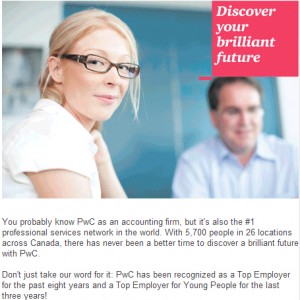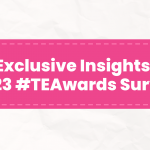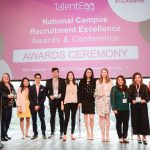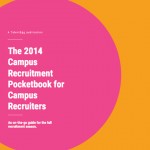The customized employer profiles on TalentEgg.ca are Gen Y’s starting point for learning about career opportunities and how each employer is unique.
Each of the employer profiles on TalentEgg is as varied as the organizations behind them, which range in size from small businesses to multinational corporations, and include industries such as oil and gas, accounting and technology, just to name a few.
But whether an employer’s brand is a household name or not, the first step to recruiting and retaining top student and new graduate talent is the same: providing as much information about the organization and its career opportunities as possible.
There are many very important questions that need to be answered and it’s essential that employer profiles touch on them all so students don’t feel confused or frustrated when interacting with an employer brand. After all, an employer’s TalentEgg profile may be the first time a student learns about an organization and their career opportunities – if the information they need is not clear to them right off the bat, they might consider one of the other hundreds of employers to be found on TalentEgg.ca instead!
How Gen Y uses employer profiles on TalentEgg
- First look: Learning about an employer for the first time
- Industry overview: Finding out which employers are key players in the industry they want to work in
- Following: Students and new grads can add employer profiles to their favourites and see the latest jobs from each of their favourite employers
- Compare and contrast: Seeing how employers stack up against each other in terms of culture, opportunities and other important criteria
- Application help: The smartest candidates will use the information found in a profile to customize their resume and cover letter
5 ways top employers make the most of their profiles
They customize their employer branding for Gen Y
Perhaps it goes without saying, but the information you present to students and new grads should be different from that which you use to attract more experienced candidates. Employers that “get it” customize their employer branding for Generation Y and minimize corporate jargon.
The key, however, is that they don’t go overboard – what reads to recruiters and HR professionals as “cool and hip” might actually be cringe-worthy to Gen Y. It’s essential to stay away from slang and texting abbreviations, otherwise students might be LOL-ing at you instead of blowin’ up your ATS with their applications. See what I mean?
The best employer profiles…
- Use a friendly, casual and conversational tone
- Avoid the use of complex industry- or company-specific words, phrases and abbreviations
- Write for an audience that knows nothing about their organization or working in their industry
- Pass the “high school test” – meaning that a teenager could understand everything written in the profile
- Break up long sentences and paragraphs, and use headings and images to make the profile more attractive and easier to read
They explain what they do, how they do it and how students fit into that picture
The best employer profiles explain what an organization does in one or two sentences on the main “Company Profile” tab and then also elaborate on that information on a separate tab, which may also link to even more detailed information on their own website.
The brief overview may not be enough to ensure students genuinely understand what an employer does – after all, how many of them actually know what a professional or technology services firm is, or what a global energy company does?
 A great example of this is PwC’s employer profile, which starts out by saying, “You probably know PwC as an accounting firm, but it’s also the #1 professional services network in the world” and then goes on to describe the firm’s service areas in more detail below.
A great example of this is PwC’s employer profile, which starts out by saying, “You probably know PwC as an accounting firm, but it’s also the #1 professional services network in the world” and then goes on to describe the firm’s service areas in more detail below.
Then students can click through to PwC’s “What We Do” tab – and the firm’s campus recruitment website – to learn even more about what it’s like to work in these departments. Choosing a service area is an essential aspect of applying to the firm, so PwC has provided extremely detailed yet audience-appropriate information about each part of the organization that students might end up working in.
They do a deep dive of their student and entry level career opportunities
Students are really checking out employer profiles to find out what they can offer them in terms of career opportunities, so it’s essential that employers don’t skimp on the details.
In a few moments, students should be able to find out:
- What types of career opportunities an employer hires for. Internships, co-ops, summer jobs, entry level jobs or early career jobs, or a combination of those?
- Which students and graduates they hire, specifying if they only hire students from certain academic backgrounds or if they’re open to all.
- When they accept applications. Students may visit employer profiles year round, so if an employer doesn’t have any job listings they need to know when they should check back. On Nexen’s profile, for example, students and new graduates know exactly when they should come back to apply.
- How their application process works. This is one of the most common student questions. Chances are most employers’ processes are less intensive than the Canadian Forces’, so if they can explain it, so can you.
- What an employer offers in terms of training, mentorship, professional development and career advancement. For example, TTi provides an easy-to-understand flowchart so new grads can see exactly where their career in sales or marketing with the company might take them.
They let their employees speak for them
Students trust their peers way more than they trust some faceless company.
Incorporating current interns and co-op students and entry level employees into an employer profile is one of the best ways to engage students with an employer brand.
Two or three short employee testimonials from students and recent grads from a variety of backgrounds that include headshots provide a deeper connection to an organization and give students an inside look at what it’s like to work with an employer.
For ideas, check out Accenture’s “Case Studies” tab, Kobo’s “What Kobo Has To Say” tab and PwC’s “Meet Our People” tab. Suncor Energy even went one step further by embedding a series of YouTube video testimonials in their profile.
They give students an opportunity to interact with them
Employers who “get it” ensure their campus recruitment or careers Twitter account, Facebook page or LinkedIn company page is easily accessible from their employer profile on TalentEgg. Some link to their social networking accounts or even embed a cool widget that allows students to follow, like or connect with them online in just one click!
Alberta Health Services invites students to connect with them online by clicking on large, visible YouTube, Twitter and Facebook icons. Meanwhile, candidates can connect directly with Starbucks recruiter Kirsti Stubbs on Twitter and LinkedIn via widgets on that company’s profile.
—
Find out how TalentEgg can help you attract top talent:
Contact Steph today at steph@talentegg.ca or 416-479-4186 x114 for more information about TalentEgg.







0 Comments
1 Pingback